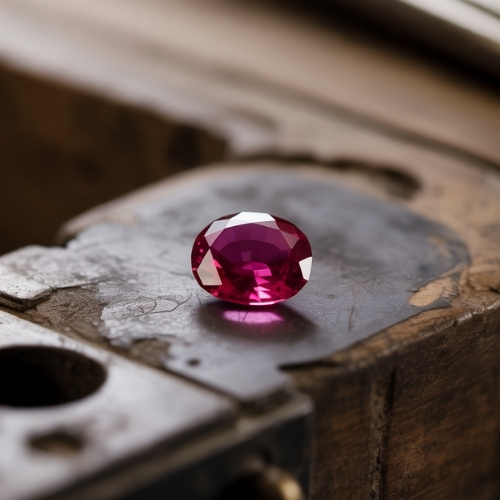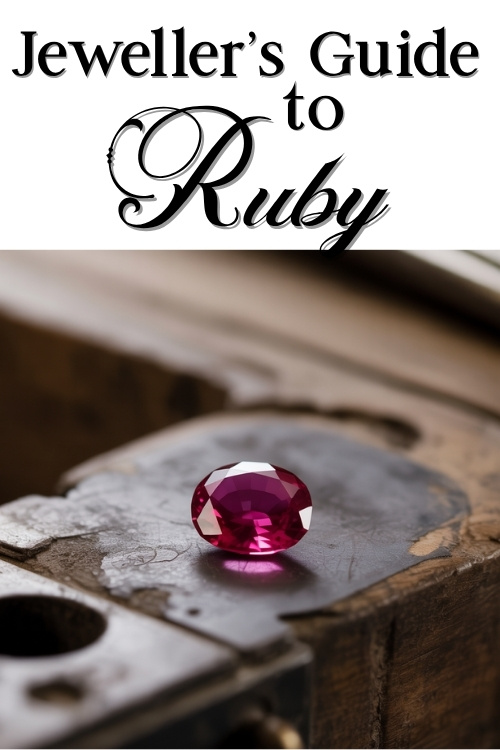Few gemstones capture the essence of passion quite like ruby. With its vivid red hues, from pink-red to crimson, ruby has long symbolised vitality, power, and desire. This bold member of the corundum family is as durable as it is dazzling, making it a favourite among jewellers and gemstone lovers alike.
Basic Identification Information
Name & Synonyms
Ruby, and Pigeon’s blood ruby for gems with high red saturation and purple undertones.
Species
Corundum
Colour Range
Pinkish-red to deep red
Refractive Index
1.762–1.770
Birefringence
0.003 to 0.019
Optical Sign
Uniaxial –
Pleochroism
Weak to Strong and 2 Colours
purplish red and orangy red
Specific Gravity
3.95–4.10
Fluorescence
Although some rubies have no response, most show a strong red fluorescence under both longwave and shortwave UV light. This is particularly noticeable in high-quality Burmese rubies.
Lustre
Vitreous (glass-like)
Clarity
Type II
Ruby typically contains inclusions, such as rutile silk. These inclusions can actually enhance a gem’s appeal by creating a soft internal glow. Eye-clean rubies do existing, but they are especially valuable.
Gems Often Mistaken For
Spinel, Garnet, Tourmaline
Mohs Hardness
9
Wearability
Excellent — ruby is one of the hardest and most durable gems for daily wear.
Birthstone
July
Spotting Synthetic (Lab-Grown) Ruby
Lab-grown rubies are chemically and structurally identical to their natural counterparts, which makes distinguishing between the two a challenging task without proper tools, in particular, magnification.
One of the most reliable indicators lies in the inclusions. Natural rubies typically display fine, thread-like rutile inclusions known as “silk,” which form naturally during crystal growth. In contrast, synthetic rubies may exhibit curved growth lines or gas bubbles, neither of which occur in natural stones.
Another clue can be found in the internal growth structure. While natural rubies often grow with angular or straight zoning patterns, synthetics frequently show curved colour zoning, especially under magnification.
Common Treatments
The vast majority of rubies available on the market today have undergone some form of treatment to improve their appearance. These enhancements are widely accepted within the industry, but it’s important for jewellers to understand what each one involves and how it affects the stone’s value and care requirements.
Heat treatment is by far the most common and is considered an industry standard. It enhances the ruby’s natural colour and can also improve clarity by dissolving fine inclusions like rutile silk. This process is permanent and generally stable under normal jewellery wear conditions.
Diffusion treatment is another method used to enhance colour, but unlike heat treatment, it only alters the surface of the stone. This technique introduces colour-causing elements such as beryllium during heating. Because the treatment affects only the outer layer, it’s not as widely accepted as heating alone.
Some rubies may also undergo oiling or fracture-filling, where surface-reaching fractures are filled with colourless oils or resins to reduce their visibility. This treatment is less common in ruby than in other gems like emerald but does occur, especially in stones with visible inclusions.
A more significant form of enhancement is lead-glass filling, which is frequently used in very low-quality ruby material. This process involves filling cavities and fractures with lead-rich glass to create the illusion of a more transparent, gem-quality stone. These rubies often contain more glass than corundum and are considered a distinct product. Under magnification, they typically show gas bubbles and an iridescent flash effect, often orange or blue, where the glass and ruby meet. While visually striking, these stones are far more fragile and require special handling.
Durability & Setting Considerations
Natural ruby is highly durable, making it a favourite for engagement rings, daily-wear jewellery, and heirloom pieces. With a Mohs hardness of 9, it resists scratches and holds up well over time.
When setting ruby, prongs should be carefully positioned to avoid stress on corners or exposed edges. Bezel settings offer both protection and a bold frame that enhances ruby’s vivid red tones.
Lead-glass-filled rubies are far less stable and need to be handled with more care. These treated stones can fracture under pressure, exposure to heat, or contact with chemicals. They should never be subjected to soldering or casting processes.
Care Instructions
Cleaning:
The safest way to clean rubies is with warm water, mild soap, and a soft brush.
Ultrasonic cleaners can be used for natural rubies with slight inclusions and lab-grown rubies, but should be avoided for heavily included stones, as the vibrations may cause damage.
Steam cleaners are generally safe for slightly included natural rubies, but should be avoided for synthetic or heavily included gems.
Both ultrasonic and steam cleaning should be avoided for glass-filled rubies, as these treatments are highly vulnerable to damage.
Storage:
Store rubies separately, preferably in a soft pouch. Although durable, ruby can be scratched by harder materials like diamond, and they can easily scratch softer gems, such as quartz.
Daily Wear:
Natural and lab-grown rubies handle everyday wear well.
Market & Ethical Notes
Fine-quality rubies are among the highest-valued gems per carat. The most coveted examples hail from Myanmar’s Mogok region, famous for producing rich, fluorescent stones, though premium rubies also come from Mozambique, Sri Lanka, Thailand, and Madagascar.
Ethical sourcing is a growing concern, particularly due to Myanmar’s political climate and history of conflict mining. Many jewellers now prioritise rubies from transparent, traceable sources or opt for lab-grown alternatives, which offer a responsible and affordable choice.
Symbolic & Spiritual Meanings
Ruby is steeped in symbolic meaning. Historically linked to nobility, war, and wisdom, it was worn by warriors in ancient Burma and India to ensure victory and courage in battle.
In modern crystal healing, ruby is a stone of vitality and love. Said to stimulate the heart chakra, it’s believed to enhance motivation, deepen passion, and encourage confidence in both life and love.
🔗 Dive deeper into Ruby’s Symbolic & Spiritual Meanings
Etymology
The name ruby stems from the Latin ruber, meaning “red.”
🔗Curious about how ruby was viewed in ancient cultures? Explore its fascinating myths and legends (coming soon)
📌 Save this jeweller’s guide to ruby for quick reference next time you’re working with this beautiful red gem.


